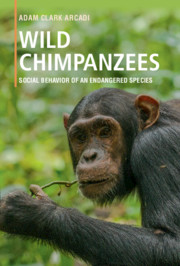Book contents
- Wild Chimpanzees
- Wild Chimpanzees
- Copyright page
- Dedication
- Contents
- Preface
- 1 Primates, Apes, and the Study of Chimpanzee Social Behavior
- 2 Seven Long-Term Field Studies
- 3 Chimpanzee Fission–Fusion Social Organization and Its Conservation Implications
- 4 Sex Differences in Ranging and Association Patterns
- 5 Female Social Relationships
- 6 Male Social Relationships
- 7 Sexual Behavior: Conflicting Strategies of Males and Females
- 8 Coalitionary Lethal Aggression between and within Communities
- 9 Hunting, Eating, and Sharing Meat
- 10 Communication: The Form and Content of Signals
- 11 Community Differences in Grooming Postures and Tool Use: Innovation, Social Learning, and the Question of “Culture”
- Epilogue
- Appendix: Field Methods for Studying Wild Chimpanzees
- End Notes
- References
- Index
- Plate Section (PDF Only)
5 - Female Social Relationships
Published online by Cambridge University Press: 01 June 2018
- Wild Chimpanzees
- Wild Chimpanzees
- Copyright page
- Dedication
- Contents
- Preface
- 1 Primates, Apes, and the Study of Chimpanzee Social Behavior
- 2 Seven Long-Term Field Studies
- 3 Chimpanzee Fission–Fusion Social Organization and Its Conservation Implications
- 4 Sex Differences in Ranging and Association Patterns
- 5 Female Social Relationships
- 6 Male Social Relationships
- 7 Sexual Behavior: Conflicting Strategies of Males and Females
- 8 Coalitionary Lethal Aggression between and within Communities
- 9 Hunting, Eating, and Sharing Meat
- 10 Communication: The Form and Content of Signals
- 11 Community Differences in Grooming Postures and Tool Use: Innovation, Social Learning, and the Question of “Culture”
- Epilogue
- Appendix: Field Methods for Studying Wild Chimpanzees
- End Notes
- References
- Index
- Plate Section (PDF Only)
Summary
OVERVIEW
A striking feature of wild chimpanzee social existence is how different the lives of adult females and males are. As in other primate species, relationships within and between the sexes are greatly influenced by sex-specific dispersal patterns. As the transfer sex, female chimpanzees upon maturity must forge completely new relationships with members of a neighboring community. Throughout their adult lives, female social behavior is then dominated by mothering, competition for resources, and often tense interactions with adult males. Males, by contrast, spend their entire adolescent and adult lives enmeshed in a complicated web of relationships with each other, relationships that are at once cooperative, competitive, and ever-shifting. As a consequence of these divergent social trajectories, the frequencies at which friendly and unfriendly behaviors are given and received among and between females and males vary tremendously.
Sex differences in behavior appear in infancy. For example, both female and male infants at Kanyawara use sticks in a number of different contexts: during play, during aggressive interactions, when probing holes for water or honey, or when otherwise occupied with their routine behaviors. They may carry them for hours at a time in their hand, under their arm, or wedged between thigh and abdomen. But whereas femalesmore thanmales simply carry sticks, sometimes taking them into day nests and resting with them in a way reminiscent of mothering behavior, males more than females use sticks in aggressive contexts. In the social sphere, male infants at Gombe begin to travel independently earlier, maintain further distances from their mothers starting at age three, and spend more time in social play than female infants. Male infants also interact more with adult males than female infants do, even though there is no difference between infant females and males in how often they interact with adult females. These early sex differences foreshadow important differences between adult females, who concentrate on offspring care and resource acquisition, and males, who devote more energy to social interactions important for navigating the male status hierarchy.
Young male and female chimpanzees can also differ in their predispositions to learn particular adult activities, laying the groundwork for later distinctions in adult behavior. For example, infant females at Gombe spend more time than infant males watching their mothers “fish” for termites with small stick tools (Chapter 11), whereas males spend more time playing around the termite mounds while their mothers fish.
- Type
- Chapter
- Information
- Wild ChimpanzeesSocial Behavior of an Endangered Species, pp. 40 - 47Publisher: Cambridge University PressPrint publication year: 2018



